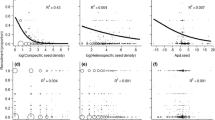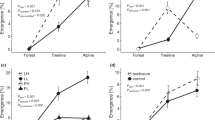Abstract
Though it is recognized that both stochastic and deterministic processes structure all communities, empirical assessments of their relative importance are rare, particularly within any single community. In this paper, we quantify the dynamic effects of dispersal assembly and niche assembly on the seedling layer in a diverse neotropical rain forest. The two theories make divergent predictions regarding the roles of seed arrival and environmental heterogeneity in generating community structure. Put simply, dispersal assembly posits that the stochasticity inherent to seed arrival structures communities, whereas niche assembly suggests that heterogeneity in post-dispersal environmental conditions is more important. We experimentally sowed 15,132 seeds of eight tree species at varying levels of density and diversity. Every six months we censused the seedlings that germinated and assessed the abiotic and biotic conditions of each plot. We assessed the density, diversity, and species composition of three nested subsets of the seedling layer: seedlings germinated from sown seeds, all seedlings germinated between July 2003 and 2004, and all woody seedlings. We partitioned the variance in density and diversity of each subset of the seedling layer into components representing seed-addition treatments and environmental conditions at 6- to 12-month intervals. Seed additions initially explained more variance in the density and diversity than did environmental heterogeneity for seven of eight sown species, but explained little variance in the density or diversity of the entire seedling layer. Species composition was better explained by seed-addition treatments than by environmental heterogeneity for all three subsets and in all time periods. Nevertheless, the variance in community structure explained by seed-addition treatments declined over the two years following germination, presaging shifts in the relative importance of dispersal assembly and niche assembly. Our study quantifies how dispersal assembly and niche assembly may vary among the components of an ecological community and shift dynamically through time.





Similar content being viewed by others
References
Arii K, Lechowicz MJ (2002) The influence of overstory trees and abiotic factors on the sapling community in an old-growth Fagus–Acer forest. Ecoscience 9:386–396
Bell G (2001) Neutral macroecology. Science 293:2413–2418
Bloor JMG, Grubb PJ (2003) Growth and mortality in high and low light: trends among 15 shade-tolerant tropical rain forest tree species. J Ecol 91:77–85
Burnham KP, Anderson DR (2002) Model selection and inference: a practical information-theoretic approach, 2nd edn. Springer, New York
Chao A, Chazdon RL, Colwell RK, Shen T-J (2005) A new statistical approach for assessing similarity of species composition with incidence and abundance data. Ecol Lett 8:148–159
Chase JM (2003) Community assembly: when should history matter? Oecologia 136:489–498
Chase JM (2007) Drought mediates the importance of stochastic community assembly. Proc Natl Acad Sci USA 104:17430–17434
Chase JM, Leibold MA (2003) Ecological niches: linking classical and contemporary approaches. University of Chicago Press, Chicago
Clark JS, McLachlan JS (2003) Stability of forest biodiversity. Nature 423:635–638
Clark JS, Macklin E, Wood L (1998) Stages and spatial scales of recruitment limitation in southern Appalachian forests. Ecol Monogr 68:213–235
Clark CJ, Poulsen JR, Levey DJ, Osenberg CW (2007) Are plant populations seed limited? A critique and meta-analysis of seed addition experiments. Am Nat 170:128–142
Condit R et al (2000) Spatial patterns in the distribution of tropical tree species. Science 288:1414–1418
Davies TJ, Barraclough TG, Chase MW, Soltis PS, Soltis DE, Savolainen V (2004) Darwin’s abominable mystery: insights from a supertree of the angiosperms. Proc Natl Acad Sci USA 101:1904–1909
Delissio LJ, Primack RB (2003) The impact of drought on the population dynamics of canopy-tree seedlings in an aseasonal Malaysian rain forest. J Trop Ecol 19:489–500
Engelbrecht BMJ, Kursar TA (2003) Comparative drought-resistance of seedlings of 28 species of co-occurring tropical woody plants. Oecologia 136:383–393
Etienne RS, Olff H (2004) A novel genealogical approach to neutral biodiversity theory. Ecol Lett 7:170–175
Fargione J, Brown CS, Tilman D (2003) Community assembly and invasion: an experimental test of neutral versus niche processes. Proc Natl Acad Sci USA 100:8916–8920
Foster SA, Janson CH (1985) The relationship between seed size and establishment conditions in tropical woody plants. Ecology 66:773–780
Foster BL, Tilman D (2003) Seed limitation and the regulation of community structure in oak savanna grassland. J Ecol 91:999–1007
Frazer GW, Canham CD, Lertzman KP (2000) Gap light analyzer (GLA), version 2.0: image-processing software to analyze true-color, hemispherical canopy photographs. Bull Ecol Soc Am 81:191–197
Fukami T (2004) Assembly history interacts with ecosystem size to influence species diversity. Ecology 85:3234–3242
Gilbert B, Lechowicz MJ (2004) Neutrality, niches, and dispersal in a temperate forest understory. Proc Natl Acad Sci USA 101:7651–7656
Gravel D, Canham CD, Beaudet M, Messier C (2006) Reconciling niche and neutrality: the continuum hypothesis. Ecol Lett 9:399–409
Harms KE, Wright SJ, Calderon O, Hernandez A, Herre EA (2000) Pervasive density-dependent recruitment enhances seedling diversity in a tropical forest. Nature 404:493–495
Harms KE, Condit R, Hubbell SP, Foster RB (2001) Habitat associations of trees and shrubs in a 50-ha Neotropical forest plot. J Ecol 89:947–959
Harpole WS, Tilman D (2006) Non-neutral patterns of species abundance in grassland communities. Ecol Lett 9:15–23
Holdridge LR (1947) Determination of world plant formations from simple climatic data. Science 105:367–368
Hubbell SP (2001) The unified theory of biodiversity and biogeography. Princeton University Press, Princeton
Hubbell SP et al (1999) Light gap disturbances, recruitment limitation, and tree diversity in a neotropical forest. Science 283:554–557
John R et al (2007) Soil nutrients influence spatial distributions of tropical tree species. Proc Natl Acad Sci USA 104:864–869
Karst J, Gilbert B, Lechowicz MJ (2005) Fern community assembly: the roles of chance and the environment at local and intermediate scales. Ecology 86:2473–2486
Kimura M (1983) The neutral theory of molecular evolution. Cambridge University Press, London
Lewis SL, Tanner EVJ (2000) Effects of above- and belowground competition on growth and survival of rain forest tree seedlings. Ecology 81:2525–2538
Makana J-R, Thomas SC (2004) Dispersal limits natural recruitment of African mahoganies. Oikos 106:67–72
Mantel N (1967) The detection of disease clustering and a generalized regression approach. Cancer Res 27:209–220
McCune B, Grace JB (2002) Analysis of ecological communities. MjM Software Design, Gleneden Beach
McGill BJ (2003) A test of the unified neutral theory of biodiversity. Nature 422:881–885
McGill BJ, Hadly EA, Maurer BA (2005) Community inertia of Quaternary small mammal assemblages in North America. Proc Natl Acad Sci USA 102:16701–16706
McGill BJ, Maurer BA, Weiser MD (2006) Empirical evaluation of neutral theory. Ecology 87:1411–1423
Montgomery RA, Chazdon RL (2002) Light gradient partitioning by tropical tree seedlings in the absence of canopy gaps. Oecologia 131:165–174
Nicotra AB, Chazdon RL, Iriarte SVB (1999) Spatial heterogeneity of light and woody seedling regeneration in tropical wet forests. Ecology 80:1908–1926
Norden N et al (2007) Is seedling dynamics determined by environment or by seed arrival? A test in a neotropical forest. J Ecol 95:507–516
Oksanen J, Legendre P, O’Hara B, Stevens MHH (2007) vegan: Community Ecology Package. R package 1.8–8. http://cran.r-project.org/; http://r-forge.r-project.org/projects/vegan/
Paine CET (2007) Ecological factors affecting the diversity of tropical tree seedlings. Louisiana State University, Baton Rouge
Paine CET, Beck H (2007) Seed predation by neotropical rainforest mammals increases diversity in seedling recruitment. Ecology 88:3076–3087
Pitman NCA et al (2002) A comparison of tree species diversity in two upper Amazonian forests. Ecology 83:3210–3224
Rosenzweig ML (1995) Species diversity in space and time. Cambridge University Press, London
Seidler TG, Plotkin JB (2006) Seed dispersal and spatial pattern in tropical trees. PLoS Biol 4:2132–2137
Shipley B, Vile D, Garnier E (2006) From plant traits to plant communities: a statistical mechanistic approach to biodiversity. Science 314:812–814
Svenning JC, Wright SJ (2005) Seed limitation in a Panamanian forest. J Ecol 93:853
R Development Core Team (2007) R: a language and environment for statistical computing. R Foundation for Statistical Computing, Vienna
Terborgh J (1990) An overview of research at Cocha Cashu Biological Station. In: Gentry AH (ed) Four neotropical forests. Yale University Press, New Haven, pp 48–59
Terborgh J et al (2008) Tree recruitment in an “empty” forest. Ecology 89:1757–1768
Tilman D (1997) Community invasibility, recruitment limitation, and grassland biodiversity. Ecology 78:81–92
Tilman D (2004) Niche tradeoffs, neutrality, and community structure: a stochastic theory of resource competition, invasion, and community assembly. Proc Natl Acad Sci USA 101:10854–10861
Tuomisto H, Ruokolainen K, Yli-Halla M (2003) Dispersal, environment, and floristic variation of western Amazonian forests. Science 299:241–244
Turnbull LA, Crawley MJ, Rees M (2000) Are plant populations seed-limited? A review of seed sowing experiments. Oikos 88:225–238
Venables WN, Ripley BD (1999) Modern applied statistics with S-Plus. Springer, New York
Volkov I, Banavar JR, Hubbell SP, Maritan A (2003) Neutral theory and relative species abundance in ecology. Nature 424:1035–1037
Volkov I, Banavar JR, He FL, Hubbell SP, Maritan A (2005) Density dependence explains tree species abundance and diversity in tropical forests. Nature 438:658–661
Webb CO, Peart DR (2001) High seed dispersal rates in faunally intact tropical rain forest: theoretical and conservation implications. Ecol Lett 4:491–499
Acknowledgments
We thank John Terborgh for his generosity in support of this project and in sharing unpublished data with us. Cecilia Carrasco, Christina Georghiou, Nataly Hidalgo, Armando Mendoza, Kristen Schmitt and Pamela Weisenhorn tagged and measured thousands of seedlings. Patricia Alvarez-Loayza identified endless seedlings and contributed to the reference collections. Discussions with Jane Carlson, Jonathan Myers and Adriana Bravo strengthened the manuscript. Peru’s National Institute of Natural Resources (INRENA) granted us permission to conduct research in Manu National Park. This research was supported through an Organization of American States LASPAU fellowship, the LSU Biology Graduate Student Association (BioGrads), and a LSU Board of Regents Fellowship to CETP, as well as a National Science Foundation grant (DEB 0614044) to KEH. The experiments performed in this study comply with the current laws of Peru, where they were performed.
Author information
Authors and Affiliations
Corresponding author
Additional information
Communicated by Scott Collins.
Rights and permissions
About this article
Cite this article
Paine, C.E.T., Harms, K.E. Quantifying the effects of seed arrival and environmental conditions on tropical seedling community structure. Oecologia 160, 139–150 (2009). https://doi.org/10.1007/s00442-008-1269-6
Received:
Accepted:
Published:
Issue Date:
DOI: https://doi.org/10.1007/s00442-008-1269-6




